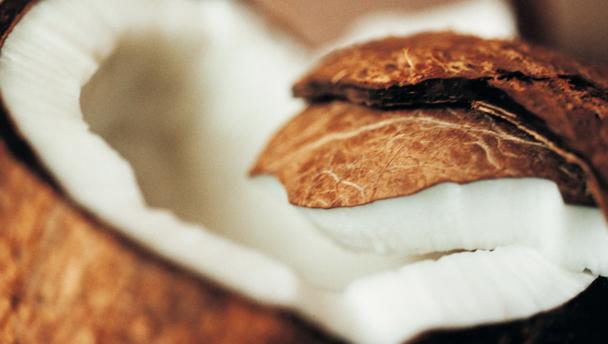

The coconut sold in the UK is the de-husked, hard, brown ‘stone’ of a ripe coconut. This brown shell has three eyes at one end. Inside is a further thin, brown, coat called the testa: the creamy-white, firm flesh of the coconut is attached to this. The middle of a coconut is hollow and filled with a sweet liquid known as coconut juice or coconut water. The testa of a coconut hardens as the coconut ripens. Occasionally, young, unripe, green coconuts are sold as ‘jelly’ coconuts: their white flesh is still soft and jelly-like with a slightly more ‘milky’ water (this liquid is not coconut milk or coconut cream).
 Dry curry of cabbage, carrot and coconut (Thoran)
Dry curry of cabbage, carrot and coconut (Thoran)
 Prawns with freshly grated coconut, green chillies and mustard seeds (Chingri daab)
Prawns with freshly grated coconut, green chillies and mustard seeds (Chingri daab)
 Thai coconut-chilli prawns
Thai coconut-chilli prawns
 Veggie kedgeree
Veggie kedgeree
 Lemongrass and ginger mussels
Lemongrass and ginger mussels
 Spiced cauliflower with toasted coconut and red lentils
Spiced cauliflower with toasted coconut and red lentils
 Rolled lemon pancakes with blueberries and yoghurt
Rolled lemon pancakes with blueberries and yoghurt
 Cake pops
Cake pops
 Pumpkin and coconut loaf cake
Pumpkin and coconut loaf cake
 Bacon, egg and cheese muffins
Bacon, egg and cheese muffins
 Sweet meringue
Sweet meringue
A young coconut should make a sloshing sound when shaken and feel heavy for its size. A mature coconut should also feel heavy and contain liquid. Avoid any that have sunken eyes or cracks.
A young coconut should be eaten within 2-3 days. A ripe coconut will last a couple of months. Pre-packed pieces of fresh coconut should be kept refrigerated.
Opening coconuts is not easy and requires great care. Place a whole mature coconut in a preheated oven at 180C/350F/Gas 4 for 15 minutes. (This will help shrink the flesh from the shell). To extract the water, place the coconut in a bowl to hold it upright. Use a drill (clean the drill piece first) to bore a hole in two of the eyes. Turn the coconut upside-down and drain the water into a slightly smaller bowl.
To split the coconut into two halves, either hold the coconut in one hand and firmly strike around its circumference with the back (not the blade) of a heavy knife or cleaver. The coconut should naturally break in half. Alternatively, place the whole coconut into a strong plastic bag, take it outside or place it onto a stone floor and hit firmly with a hammer around the coconut’s circumference. A third option is to ask the grocer you bought the coconut from to break it open for you.
To make coconut cream and coconut milk, peel away the brown skin from the white coconut flesh and place the flesh into a food processor with some hot water. Blend thoroughly, then squeeze the mixture through some muslin or a clean tea towel into a plastic, china or glass bowl (coconut reacts to metal) and set the liquid aside for 20 minutes. The coconut cream will float to the top of the milk and can be spooned off the surface. This process can be repeated to make extra coconut milk. One coconut yields about one cup of coconut cream.
Use freshly grated coconut in curries and creamy puddings, or lightly toast it with spices and use as a seasoning. Desiccated coconut is made from the dried, white flesh (copra) of the coconut. Use in place of freshly grated coconut. It is also delicious added to meringues, cakes, biscuits and cream tarts.
Article by Sybil Kapoor
Type the ingredients you want to use, then click Go. For better results you can use quotation marks around phrases (e.g. "chicken breast"). Alternatively you can search by chef, programme, cuisine, diet, or dish (e.g. Lasagne).